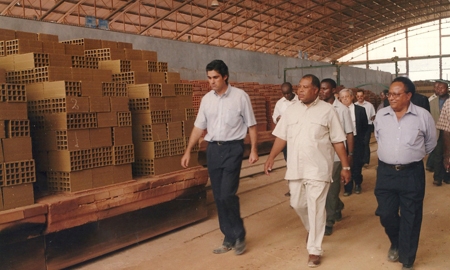
How would you describe the evolution of the building sector and the ceramics industry in Angola after the civil war?
After the civil war ended in 2002, the building sector developed a lot, particularly Uniceramica. Uniceramica was created by the government to provide building materials like brick, bathroom suites, and so on. Our mission at Uniceramica is to pioneer the industry first, and then form partnerships with private companies, eventually handing the factories to them so that they keep producing materials.
How many factories does Uniceramica operate?
At the moment Uniceramica in Luanda has three: one in Petrangol, one in Cacuaco and one in Kifangondo, which is called Novice and produces 50,000 units per day. We also have factories in Porto Amboi, Uacucungo, Huambo and Catete. The first three in equal partnership with Mota Engil. These four produce 59,000 units per day, or 354 tonnes per day.
The new government programme calls for building more than 20 factories, each of them with a production of between 35,000 and 50,000 units per day.
Why all this production? Is there much demand?
Yes, there is. At the moment the country has planned to build a million houses for middle and lower classes. It means that these seven factories plus the 20 new ones, or 27 in total, will represent only 20 per cent of demand.
What is the government doing in order to reduce the dependence of importation?
We use to depend on imports, and we still depend on imports of tile and other special bricks. With this new factory we will reduce the importation of bricks, tiles and bathroom suites – for instance, one of the 20 factories will produce bathroom suites, mosaics and tiles.
How strongly was the ceramics industry affected by the financial and economic crisis in Angola?
Not too much, because we are not producing a lot. These seven factories plus the 20 factories that will be built do not represent the boom, we need more factories until we reach 50. Angola during the colonial period did not have the same factories as today, but had more than 270 factories; every municipality, every town use to have a ceramics factory, small or big. All were destroyed because of the war, so now we have to build new ceramics factories.
Which material do you use for manufacturing?
We use clay; in Angola there is clay everywhere. All substances are from Angola, the ceramic products are 100 per cent Angolan and of each region: products in Huambo are from Huambo, Benguela products are from Benguela, etc. Our objective is to export as well, once we’ve got all 50 factories up and running and can cover internal demand. We plan to sell our products in Namibia when we open a factory in Cunene. The Negas factory is to sell ceramics in Zaire, the Nzeto factory is to sell ceramics in Zaire, and the Kuando Kubango factory is to sell in Zambia.
Is Uniceramica searching for partnerships with English investors?
Yes, but at the moment we don’t have any English partners yet, my only partnership is Portuguese – with Mota Engil. However, if I find a Spanish or an English company that want to work with us, they will be welcome. There is space for everyone in Angola.
0 COMMENTS